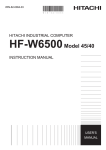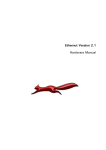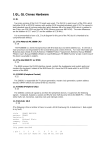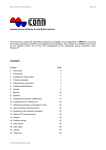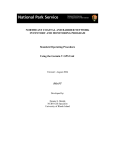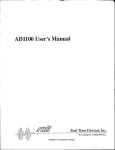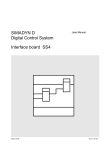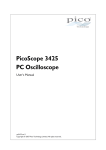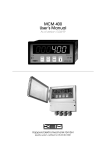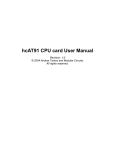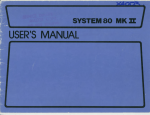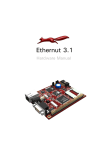Download 68008 CPU card for the APPLE
Transcript
Paul Rojas, Frank Darius, Jürgen Drepper 68008 CPU card for the APPLE - II The following project is again evidence for the flexibility of the Apple-II, that is resulting from its concept of providing slots. A card with the 68008 CPU that is internal compatible with the 68000 CPU. The card operates similar to the common Z80 CPU cards but provides internal full 32-bit structure of the 68008. One of the most popular processorfamilies is the 68000 among the 16/32 bit CPUs. The success of the product from Motorola is the internal architecture that provides a very comfortable set of commands and twelve kinds of addressing the memory. The advanced 68010 can address up to 16 megabyte by using a virtualisation technic and supports this with a very intelligent prefetch-queue, that itself speeds up small loops within the programs. The 68000 provides internal 8 data- and 8 adressregisters with 32 bit size allthough the databus itself only consists with 16 lines. So it just was a question of time until a true 32bit version entered the market when in June 1984 the 68020 was introduced in the USA and it was compatible to the 68000 and the 68010. Motorola offers a chip the is able to execute 2,5 MIPS( million instructions per second ) and that can address up to 4 Gigabyte of logic memory. From the 68000 CPU there is also a "small brother" available with an external Databus with 8 lines - the 68008. By that the cpu is compatible to other 8-bit CPUs and can thereby access their memory and peripherials. So there is a good path to integrate the 68008 in old computers. By this attempt the user gets the chance to use a cpu from the 68000family without the need to buy separate data-memory and separate peripherials. This is exactly the target of this project and the circuitary fullfills the goals by making a card for the Apple slot. The 6502 cpu of the Apple-II is switched off and the rest of the computer is ruled by the 68008 cpu similar to the handling by the Z80 cpu-cards. The control can be given back to the 6502 by software to control the monitor - routines to display for example the results of the program to the user at the display. Both cpu´s can share the same RAM and interchange with operation. The Hardware Problems The Apple provides the user with eight slots on the mainboard that permit the attachment of additional CPU-cards. Besides the databus and the adressbus also several timing and control-lines are provided that can be used by the inserted cards. For example the line 22 in the slot is the DMA-line that controls the Direct Memory Access. If this line is pulled down to low ( i.e. 0 Volt ) the address- and datebuslines are triggered to the tristate-status and the 6502 is stopped. Alternating CPUs or peripherials are then enabled to access the address- and datalines and are permitted to perform read - or write-cycles to the logic memory ( RAM, ROM or IO addresses ). For the clueless handover to the alternating cpu the accesses of the 6502 must be completed before and for the handover of the control to the 68008 the following tasks must be executed: 1) DMA must be set during Φ1 ( videophase ) to low. 2) 30 ns thereafter the adressbus of the 68008 is permitted to become active. For the return of the control to the 6502 the following must be performed: 1) The address and databuffers must be set back to tristatestatus. 2) the DMA-line must be dragged up to high within 178ns after the positive rise of the Φ1 in oder to give the 6502 the possibility to set his own adressbus within proper time ( see picture 1 ). It must be kept sure that only one of both cpu´s has access to the memory or the peripherials and that the correct protocol of the DMA is respected. the picture displays the timing of the read- and write-cycles at the Apple II Plus - but carefull: at the Apple IIe the timing slightly shifted ! One of the difficulties results from the length of the period of DMA access. The NMOS 6502 cpu is a dynamic processor and it must be avoided to shut off the processor for more than 40 microseconds ( Rockwell only 17 microseconds ). Otherwise the cpu will loose the contents of its registers and then will jump to an unpredicted address after the end of the DMA-accesses. Therefor DMA accesses must be limited to a maximum of less than 40 microseconds. To keep the registers of the 6502 preserved the DMA must be limited within this limits periodically by short intermediate shutdowns.. This card realizes the task by using a hardware counter driving the timing: each 16 microseconds the 6502 performs a wait-cycle. While the 68008 controls the system every 16 microseconds a waitcycle for the 6502 occurs ( picture 2 ). The circuitplan of the 68008 The introduced circuit (picture 3 ) contains from single blocks that consist as individual function-blocks. In the part 5 of the circuit the adresslines are buffered from the Apple and the adresslines above A12 the 74LS283 adds a 1 to them. By this trick the 68008 adresses as 0 the Apple-adress $1000 and all other addresses are shifted the same way 4 kByte upwards and that mapping protects the zeropage of the 6502 and the trap-vectors of the 68008 are relocated to another place. By this trick both cpu´s can be switched without conflict to each other. The flipflop in part 1 takes control of the switching of the card. By a write-access to the address $Cx00 ( x represents the slot no. ) the IOSEL and R/W lines are set to low and the Q-line of the flipflop switches to low too. By an OR-gates and 4 Inverters the address-buffers are activated and DMA is set to low. The arrangement of the inverters causes a shifting in the timing needed for the switching of the buffers and Qinvert of the flipflop drives the activation of the 68008. Another access to the same address - but from the 68008 switches the card off and passes the control back to the 6502. The buffers of the card are switched to tristate-mode and the HALT-line is drawn down to low. The HALT is also drawn down to low by reset as needed for the 68008. The architecture of the Apple request the DMA and RDY-line to be driven with open-collector and same is requested for the HALT and the RES of the 68008 cpu. Both cpu´s can only use half of the time the memory and for the rest of the cycles the memory receives refresh by the video-access - but already during the video-phase the cpu must set the address for the next access. If you want to keep within the permitted timeframe the preparation of the access must start preparation 300ns after the starting of the videophase. For a RAM-read-access the data is available 468 ns after the positive rise at the Φ0 on the databus to the cpu. The access to the ROM and Keyboard the delay is smaller till the data is available at the databus. For write-access the data must be latest 210 ns after the rise at the Φ0 availianle at the databus and must be for the period of at least minimum of 55 ns accessable. The two chips 74LS373 and 74LS244 in part 3 of the circuitplan drive the databus in both directions. It also probably might be possible to use a transceiver but due to the fact that the data from the keyboard only has a short hold-time after the positive rise at the Φ0 on the databus it is more secure to use a latch that is opened and closed with Φ0 ( Pin 11 ). It is the same technic as used by the Z80 cards. the three flipflops in a row ( part 2 of the circuitplan ) are used to control the timing of the read- and write-cycles. At the end of a cpu-cycle the DTACK pin of the 68008 ( which is a indicator of a successful reador write-cycle ) if at the address-bus a address was available - this must be true not later than 300 ns after the beginning of the preleading video-phase. At the same time the flipflops secure that no access to the databus can be performed within the video-phase at the 74LS244. The counter ( 74LS393 ) is responsible for the refresh of the 6502. Every 16 µs it generates a signal that deactivates the address-buffer of the card at the beginning of a videophase and pulls up the DMA-line to high for the period of one microsecond. The RDY-line remains low and therefore a wait-cycle is performed with the 6502. After the 6502 has performed the waitcycle and the registers of the 6502 have been refreshed by this action, the control is given back to the 68008 cpu at the next video-phase. A line from the refresh-signal to the row of flipflops keeps sure that at the card the DTACK pin of the 68008 cant be pulled down to low. The CLK-line of the 68008 is connected to the 7MHz-line of the Apple. Allthough the cpu can operate up to 8 MHz it is fixed by this line to operate asyncronous to the Φ0 and the Φ1 signals. This opes a "time-window" of 15 microseconds to the data-bus and closes that window for 1 microsecond for the refresh of the 6502 cpu. This is a difference to the usual Z80 cards that are syncronized with the video- and cpu-phases of the Apple. The 68008 has at 94% of the CPU-phase the possibility to access the addressing and databusses. But the speed of the cpu is not really limited by the remaining 6% - its more limited by the slow access and speed of the AppleRAM chips. This is compensated a little by the prefetch-queue of the 68008: Each time the cpu is executing internal operation and no instructions to the bus are done the next instruction is read by it. Two important details at the end: This card must be placed at the beginning of the DMA-chain in the computer ( i.e. slots ) with the highest priority ! The Card is designed for the use in an Apple II or II+ and / or compatibles. For use in the IIe the timing of the card must probably be changed slightly. The 74LS393 chip has an additional counter that might be used for this purpose. Picture 4 shows the card at the soldering side, picture 5 shows the card at the side where it is populated and picture 6 shows where the IC´s and other components are to be placed. The Testprogram The picture 7 displays a small Testprogram that writes alternating a A or B to the display. The Programm is loaded to the address $1000 of the Apple ( the address 0 for the 68008 ). To end the cycles a reset puts back the computer to the regular Applemode. The program can be written with the monitor in the Apple-memory ( for slot 3 ) and the command C300 ( return ) starts it. If you want the program to terminate by itself and hand back control to the Apple you just must write a zero in the address $Cx00 ( $Bx00 for the 68008 ), where x represents the slotnumber ( picture 8 ). If the user wants to write larger programs for the card it is usefull to use one of the available crossassemblers for DOS and the 68000. Literature: [1] Starnes T.W.: Design Philosophy behind Motorola´s M6800, Byte April, May and June 1983 [2] Baum P.: DMA Protocol - Call A.P.P.L.E , April 1984 [3] Gayler W.D.: the Apple II Circuit description, Howard W. Sams Co. Indianapolis 1983 [4] Hilf W.; Nausch A.: M68000 Family Part 1 Te-Wi publishing, Munich 1984 [5] Apple II User Manual [6] Microsoft Z80 Card User Manual Addendum / Corrections 68008 card for the APPLE-II mc 1985, Issue 9, Side 46 In the circuitplan ( picture 3 ) is the pin 11 of the IC 1 ( 74LS373 ) connected with Φ1 of the Slotconnector ( connection 38 ) - in facr the pin of the 74LS373 must be connected ( as displayed in the layout of the PCB ) to the Φ0 ( the connection 40 at the slot ). 68008 card for the APPLE-II mc 1985, Issue 9, Side 46 It turned out that with some compatible computers the 68008 card faced timingproblems. In the most cases this issue was just simply solved by swapping the 74LS74 to standard 7474 chips. In very rare cases it happened that the contents of the memory-cells changed when switching the control from 6502 to 68008 or backwards.This problem was related in that specific cases to problems with temperature and was solved by adding a capacitor with a value between 100 pF and 300 pF between pin 36 ( HALT ) of the 68008 and ground - that delays the HALTsignal a very little bit and avoids conflict with the DMA-access. Another advice would be to swap the ICs 10 and 11 ( 74LS05 and 74LS20 ) against faster versions ( i.e. 74ALS05 and 74ALS29 ). In case that all these steps did not solve an existing problem the LS-typ chips should be swapped again back to the LS-versions and remove the capacitor. But instead solder a resistor with 1 kilo Ohm between pin 8 and pin 10 at IC10 ( the 74LS05 ). With this solution the trouble will be solved surely but at the trade that the 68008 cpu will operate at less speed. The card should not be used at the same time in a system as the Z80 card. It should be avoided - unless the card has been altered like in the correction description of the issue 2 of this year. Remark from me: Unfortunately I don´t have that issue…. So the only sure solution is to pull the Z80 card out of the computer, when working with the 68008 card !







